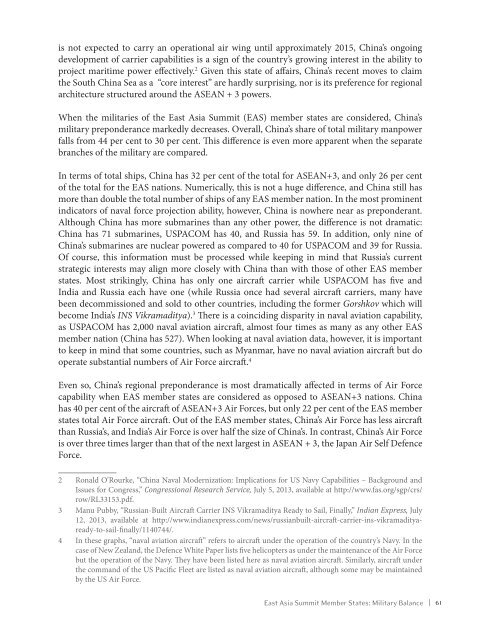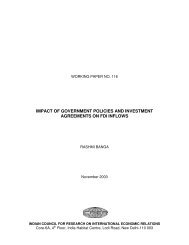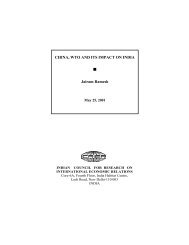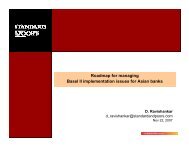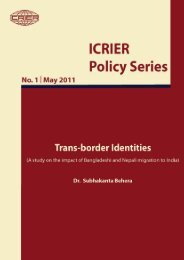Asia's Arc of Advantage - icrier
Asia's Arc of Advantage - icrier
Asia's Arc of Advantage - icrier
You also want an ePaper? Increase the reach of your titles
YUMPU automatically turns print PDFs into web optimized ePapers that Google loves.
is not expected to carry an operational air wing until approximately 2015, China’s ongoing<br />
development <strong>of</strong> carrier capabilities is a sign <strong>of</strong> the country’s growing interest in the ability to<br />
project maritime power effectively. 2 Given this state <strong>of</strong> affairs, China’s recent moves to claim<br />
the South China Sea as a “core interest” are hardly surprising, nor is its preference for regional<br />
architecture structured around the ASEAN + 3 powers.<br />
When the militaries <strong>of</strong> the East Asia Summit (EAS) member states are considered, China’s<br />
military preponderance markedly decreases. Overall, China’s share <strong>of</strong> total military manpower<br />
falls from 44 per cent to 30 per cent. This difference is even more apparent when the separate<br />
branches <strong>of</strong> the military are compared.<br />
In terms <strong>of</strong> total ships, China has 32 per cent <strong>of</strong> the total for ASEAN+3, and only 26 per cent<br />
<strong>of</strong> the total for the EAS nations. Numerically, this is not a huge difference, and China still has<br />
more than double the total number <strong>of</strong> ships <strong>of</strong> any EAS member nation. In the most prominent<br />
indicators <strong>of</strong> naval force projection ability, however, China is nowhere near as preponderant.<br />
Although China has more submarines than any other power, the difference is not dramatic:<br />
China has 71 submarines, USPACOM has 40, and Russia has 59. In addition, only nine <strong>of</strong><br />
China’s submarines are nuclear powered as compared to 40 for USPACOM and 39 for Russia.<br />
Of course, this information must be processed while keeping in mind that Russia’s current<br />
strategic interests may align more closely with China than with those <strong>of</strong> other EAS member<br />
states. Most strikingly, China has only one aircraft carrier while USPACOM has five and<br />
India and Russia each have one (while Russia once had several aircraft carriers, many have<br />
been decommissioned and sold to other countries, including the former Gorshkov which will<br />
become India’s INS Vikramaditya). 3 There is a coinciding disparity in naval aviation capability,<br />
as USPACOM has 2,000 naval aviation aircraft, almost four times as many as any other EAS<br />
member nation (China has 527). When looking at naval aviation data, however, it is important<br />
to keep in mind that some countries, such as Myanmar, have no naval aviation aircraft but do<br />
operate substantial numbers <strong>of</strong> Air Force aircraft. 4<br />
Even so, China’s regional preponderance is most dramatically affected in terms <strong>of</strong> Air Force<br />
capability when EAS member states are considered as opposed to ASEAN+3 nations. China<br />
has 40 per cent <strong>of</strong> the aircraft <strong>of</strong> ASEAN+3 Air Forces, but only 22 per cent <strong>of</strong> the EAS member<br />
states total Air Force aircraft. Out <strong>of</strong> the EAS member states, China’s Air Force has less aircraft<br />
than Russia’s, and India’s Air Force is over half the size <strong>of</strong> China’s. In contrast, China’s Air Force<br />
is over three times larger than that <strong>of</strong> the next largest in ASEAN + 3, the Japan Air Self Defence<br />
Force.<br />
2 Ronald O’Rourke, “China Naval Modernization: Implications for US Navy Capabilities – Background and<br />
Issues for Congress,” Congressional Research Service, July 5, 2013, available at http://www.fas.org/sgp/crs/<br />
row/RL33153.pdf.<br />
3 Manu Pubby, “Russian-Built Aircraft Carrier INS Vikramaditya Ready to Sail, Finally,” Indian Express, July<br />
12, 2013, available at http://www.indianexpress.com/news/russianbuilt-aircraft-carrier-ins-vikramadityaready-to-sail-finally/1140744/.<br />
4 In these graphs, “naval aviation aircraft” refers to aircraft under the operation <strong>of</strong> the country’s Navy. In the<br />
case <strong>of</strong> New Zealand, the Defence White Paper lists five helicopters as under the maintenance <strong>of</strong> the Air Force<br />
but the operation <strong>of</strong> the Navy. They have been listed here as naval aviation aircraft. Similarly, aircraft under<br />
the command <strong>of</strong> the US Pacific Fleet are listed as naval aviation aircraft, although some may be maintained<br />
by the US Air Force.<br />
East Asia Summit Member States: Military Balance | 61


